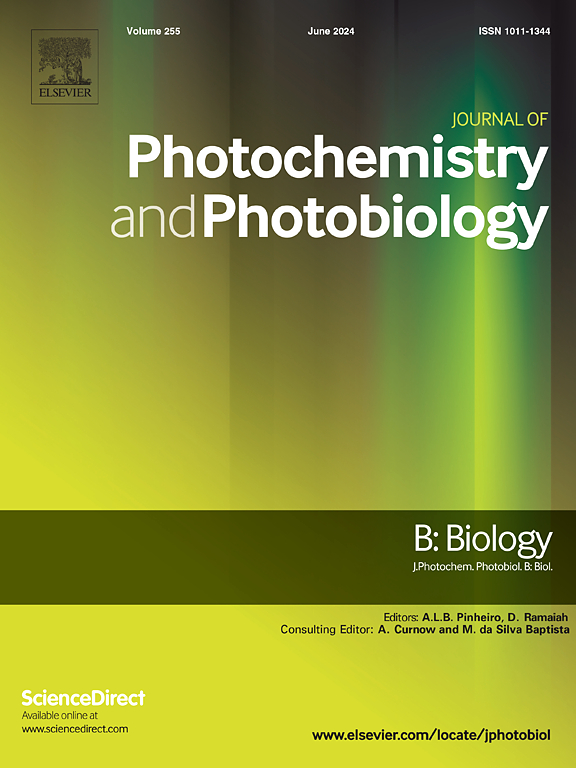1,9-二甲基亚甲基蓝- DMMB和激光对硫酸盐还原菌的光失活研究。
IF 3.7
2区 生物学
Q2 BIOCHEMISTRY & MOLECULAR BIOLOGY
Journal of photochemistry and photobiology. B, Biology
Pub Date : 2025-02-01
DOI:10.1016/j.jphotobiol.2025.113103
引用次数: 0
摘要
每年,由于硫酸盐还原菌(SRB)的存在,油气行业都面临着设备损失和产品质量下降的问题。考虑到SRB的负面影响,本研究评估了在SRB财团中使用不同浓度的1,9-二甲基亚甲基蓝(DMMB)氯化锌双盐作为光敏剂(PS)的光失活(PI),并与不同暴露的激光联合使用。培养生长采用改良的Postgate C培养基(不含硫酸亚铁),在100 μL培养基上进行细胞定量,在室温无氧无光环境下用分光光度计(λ600 nm)读取。统计分析采用双向方差分析和交互作用方差分析,分别和联合评价PS和光照对PI的影响。结果表明,各组的微生物活性均高于50% (p < 0.05)。综上所述,PI在油气行业是一种很有前景的杀菌剂替代品,具有易于应用、避免细菌耐药性、环境安全、与其他SRB种群控制技术兼容的特点。本文章由计算机程序翻译,如有差异,请以英文原文为准。

Photoinactivation of sulfate-reducing bacteria using 1,9-dimethyl-methylene blue – DMMB and laser light
Annually, the oil and gas industry faces equipment losses and product quality degradation due to the presence of sulfate-reducing bacteria (SRB). Given the negative impact of SRB, this study evaluates the use of photoinactivation (PI) with zinc chloride double salt of 1,9-Dimethyl-Methylene Blue (DMMB) as a photosensitizer (PS) in varying concentrations and combined with Laser light at different exposures in an SRB consortium. For culture growth, a modified Postgate C medium (without ferrous sulfate) was used, and cell quantification was performed on 100 μL aliquots of the consortium, read on a spectrophotometer (λ600 nm) in an oxygen- and light-free environment at room temperature. Statistical analyses included two-way ANOVA and ANOVA with interaction to separately and jointly evaluate the effects of PS and light in PI. Results indicated microbial activity in all groups, with an antimicrobial inhibition rate exceeding 50 % (p < 0.05) for concentrations above 1.5 μg/mL of DMMB. PI efficacy significantly depended on DMMB concentration and light density, achieving a 70.58 % (55.73–70.58, with a mean of 66.71 %) reduction (p < 0.05) with 1.5 μg/mL of DMMB and a 70.15 % (65–70.15, with a mean of 68.21 %) reduction with 2.0 μg/mL at an intensity of 21.6 J/cm2. In conclusion, PI presents a promising alternative to biocides in the oil and gas industry, offering easy application, avoiding bacterial resistance, being environmentally safe, and compatible with other SRB population control techniques.
求助全文
通过发布文献求助,成功后即可免费获取论文全文。
去求助
来源期刊
CiteScore
12.10
自引率
1.90%
发文量
161
审稿时长
37 days
期刊介绍:
The Journal of Photochemistry and Photobiology B: Biology provides a forum for the publication of papers relating to the various aspects of photobiology, as well as a means for communication in this multidisciplinary field.
The scope includes:
- Bioluminescence
- Chronobiology
- DNA repair
- Environmental photobiology
- Nanotechnology in photobiology
- Photocarcinogenesis
- Photochemistry of biomolecules
- Photodynamic therapy
- Photomedicine
- Photomorphogenesis
- Photomovement
- Photoreception
- Photosensitization
- Photosynthesis
- Phototechnology
- Spectroscopy of biological systems
- UV and visible radiation effects and vision.

 求助内容:
求助内容: 应助结果提醒方式:
应助结果提醒方式:


